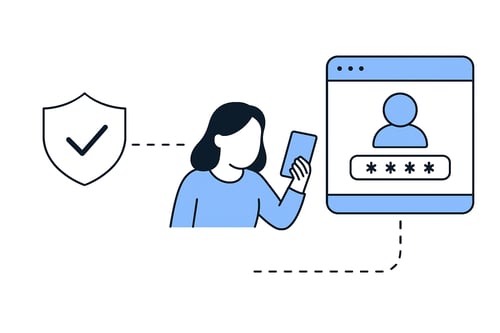CIAM – secure customer identity and access management for compliance
Customer Identity and Access Management (CIAM) has become a critical infrastructure component for banks, fintechs, and insurers.
It manages how customers authenticate, access, and interact with digital services while keeping personal data secure and compliant.
In today’s regulatory environment — shaped by DORA, PSD3, and AML rules — CIAM is no longer just an IT function. It’s a compliance and trust system that must prove who accessed what, when, and why.
Modern CIAM combines authentication, authorization, and auditability, backed by privacy-preserving computation and decentral identity.
The role of CIAM in regulatory compliance
CIAM platforms connect identity verification, fraud monitoring, and user authentication into one system.
For regulated institutions, they provide the evidence trail required by financial and data protection authorities.
A compliant CIAM framework supports:
- AML/KYC integration: links verified identities from onboarding to access.
- DORA resilience requirements: ensures secure and continuous authentication across systems.
- GDPR compliance: enforces data minimization and consent management.
- Audit readiness: logs access events and privilege changes for regulator review.
When implemented with privacy-preserving design, CIAM becomes both a compliance safeguard and a customer trust driver.
Related: See ID Verification (IDV) for how verified identity data connects directly into CIAM access systems.
From user authentication to continuous identity assurance
Traditional access systems rely on static credentials — passwords, tokens, or SMS codes — which are increasingly vulnerable to phishing and credential theft.
Modern CIAM platforms instead use continuous identity assurance, combining behavioral analytics and adaptive authentication to confirm legitimacy throughout a session.
This is achieved through:
- Strong Customer Authentication (SCA): dynamic multi-factor verification aligned with PSD2 and PSD3.
- Behavioral analytics: tracking login patterns and device usage to detect anomalies.
- Risk-based access control: using Transaction Risk Scoring models to adapt security levels.
- Federated identity management: enabling secure login across multiple platforms using one verified profile.
This continuous approach ensures that user access remains compliant, not just secure.
Related: Read Decentral identity to see how distributed credentials improve authentication reliability.
Integrating privacy-preserving computation into CIAM
CIAM systems collect and process large volumes of personal data — identity credentials, behavioral patterns, and device fingerprints.
Without strong privacy controls, this creates significant compliance and reputational risk.
By integrating privacy-preserving computation, organizations can analyze user behavior and access risk without exposing raw personal data.
This enables:
- Encrypted analytics: fraud detection and risk scoring performed on protected data.
- Multi-organization collaboration: banks and regulators can verify access risk securely.
- Data sovereignty compliance: sensitive information never leaves its jurisdiction.
- Regulatory trust: clear, auditable proof that privacy controls are active and measurable.
This same principle underpins Privacy-preserving computation, which supports secure data sharing without compromising confidentiality.
CIAM and operational resilience under DORA
The Digital Operational Resilience Act (DORA) introduces new expectations for how financial institutions manage ICT systems, including customer authentication and access management.
Under DORA, CIAM plays a key role in demonstrating system integrity, incident traceability, and third-party risk control.
To comply, institutions must:
- Maintain secure, resilient authentication mechanisms across all digital platforms.
- Ensure access logs are tamper-proof and retrievable for audits.
- Test access recovery systems as part of DORA resilience drills.
- Integrate CIAM data into operational risk management frameworks.
CIAM has evolved from a convenience tool to a pillar of operational resilience, connecting cybersecurity and compliance.
Related: See RegTech for how technology-driven compliance is reshaping risk governance.
Challenges in CIAM implementation
Adopting enterprise-scale CIAM presents both strategic and operational challenges:
- Legacy systems: outdated authentication tools lacking regulatory features.
- Data fragmentation: identity data spread across disconnected systems.
- Vendor complexity: inconsistent API and data standards among providers.
- Privacy regulation overlap: aligning GDPR, AML, and DORA simultaneously.
Financial institutions addressing these issues are increasingly adopting modular CIAM architectures built on open standards and privacy-preserving computation.
“CIAM is no longer just about keeping users in — it’s about keeping systems accountable. Regulators now expect every login and every access request to be verifiable, auditable, and private.”
– Mark Medum, CPO, Partisia
This reflects the reality that digital identity management is now a compliance instrument, not just a security layer.
Advancing privacy-first CIAM for financial services
Partisia helps institutions modernize CIAM systems for the new era of digital resilience and privacy compliance. Its privacy-preserving data collaboration platform combines Multi-Party Computation (MPC) and Confidential Computing to enable secure, compliant identity and access management.
With Partisia, organizations can:
- Integrate privacy-preserving verification directly into CIAM workflows.
- Enable real-time, risk-based access controls without data exposure.
- Meet DORA, PSD3, GDPR, and FATF requirements simultaneously.
- Align CIAM systems with Decentral identity and IDV for cross-platform compliance.

2025.10.30


